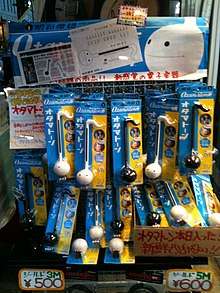Otamatone
The Otamatone (Japanese: オタマトーン, Hepburn: Otamatōn) is an electronic musical synthesizer. It was developed in Japan in 1998 by the CUBE toy company and the Maywa Denki design firm,[1] led by the brothers Masamichi and Nobumichi Tosa.[2]
Otamatone logo | |
 Several Otamatones in a store | |
| Product type | Electronic musical synthesizer |
|---|---|
| Owner | Maywa Denki |
| Country | Japan |
| Introduced | 2009 |
| Website | https://otamatone.jp |
Description
The Otamatone is a singing toy whose body is shaped like a quaver (it also somewhat resembles a tadpole, "otamajakushi" being Japanese for "tadpole"), with sound emerging from a "mouth" on the notehead. It requires two hands to play: while one hand holds and squeezes the "head", the other hand controls the pitch of the tune by placing the finger on a ribbon controller on the stem; a higher position on the stem creates a lower sound.[3] The ribbon controller is deliberately delinearized to resemble a guitar, so there is a shorter distance between higher notes than between lower ones. Varying the pressure on the head (thereby opening and closing the "mouth" of the Otamatone) creates a wah-wah effect, and shaking the neck (and thereby slightly changing pressure on the head) creates a vibrato effect. Switches on the back of the head allow users to change octave, turn it off or on, or change the volume.
The sound made by this toy can be compared to the sound of a theremin,[4] synthesizer, or jinghu.
Variants
Multiple versions are available:
- The original Otamatone in black, white, yellow, blue, and pink, and two transparent "skeleton" colours;
- The Otamatone Melody, or Otamatone Mini, a tiny variant which has no note selection slide and thus plays only predetermined tunes, also available in multiple colors;
- The Otamatone Neo, a 10th Anniversary Edition improved for better playability with a slightly wider fingerboard than the original and compatibility with the Otamatone Studio app which allows for different sounds to be played. Available in black and white only;
- The Otamatone Deluxe, a slightly larger version (44 cm) with a longer neck, a line-out jack, a power entry, a three-level pitch switch and an analog volume knob. Available in black and white only;
- The Otamatone Techno, an improved version of the Deluxe that can link to a smartphone app for extra features;
- The Otamatone Wahha GoGo, similar to the original but with an alternate design with teeth based on the Wahha Gogo "laughing machine" developed by Maywa Denki in 2009, available in silver and gold and black;
- The Otamatone Digital, which replaces the slide-based note selector with a small piano-style keyboard, it allows chords to be played as well as multiple notes simultaneously. It is also capable of reproducing electric guitar or percussion sounds;
- The Otamatone Jumbo, a much larger version played side-slung like a guitar and incorporating a clamp to use to squeeze the mouth, used only at demonstration events.[5]
References
- "about Otamatone". Retrieved 11 Jan 2017.
- "Maywa Denki". Retrieved 11 Jan 2017.
- Sarah M. Schlachetzki (March 2014). Fusing Lab and Gallery: Device Art in Japan and International Nano Art. transcript Verlag. pp. 35–. ISBN 978-3-8394-2026-3.
- "About Otamatone". Retrieved 24 May 2014.
- "Otamatone shop". Retrieved 24 May 2014.